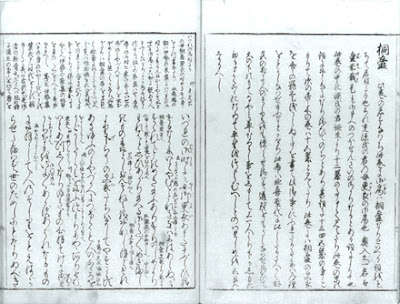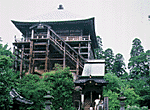. Legends about Kyogen 狂言 .
:::::::::::::::::::::::::::::::::::::::::::::::::::::::::::::::::::::::::::::::::::::::::::::::::::
Kabuki Theater ... 歌舞伎
***** Location: Japan
***** Season: Various, see below
***** Category: Humanity
*****************************
Explanation
An Introduction to Kabuki
Ryohei Matsuda
The word "kabuki" is usually written with three Chinese characters:
ka (songs), bu (dance), and ki (skills). But it actually derives from the classical Japanese verb kabuki meaning "to incline." It also carries the meaning of something eccentric or deviating from the norm.
The action in kabuki plays commonly revolves around Buddhist notions such as the law of retributive justice and the impermanence of things. Confucian traditions of duty, obligation, and filial piety are also expressed on stage.
Historically, kabuki performances have been "off-beat," employing flamboyant costumes, elaborate makeup, and exaggerated body movements to create a sense of the spectacular. This may sound strange to those who imagine that Japanese people highly value harmony and conformity in society. It is ironic that many Japanese people take pride in kabuki as being one of Japan's cultural treasures, but similar eccentric behavior in actual life is highly disapproved of.
Read the full story HERE !
© Ryohei Matsuda
. . . . .
Invitation to Kabuki
Guidance for Kabuki Appreciation
source : unesco/kabuki
Ronald Cavaye explains Kabuki
歌舞伎美人 kabukibito
source : www.kabuki-bito.jp
. WKD : Edo Sanza 江戸三座
the three famous Kabuki theaters of Edo .
:::::::::::::::::::::::::::::::::::::::::::::::::::::::::::::::::::::::::::::::::::::::::::::::::::::::

Actor Arashi Kitsusaburo I (Rikan)
in the dressing room mirror, with wigs and makeup for various roles"
Shunkōsai Hokushū 春好斎北洲 Shunkosai Hokushu (at.1809-1832)
:::::::::::::::::::::::::::::::::::::::::::::::::::::::::::::::::::::::::::::::::::::::::::::::::::::::
Kyogen, kyoogen 狂言
 Kyogen (literally "mad words" or "wild speech") is a form of traditional Japanese theater. It developed alongside noh, was performed along with noh as an intermission of sorts between noh acts, and retains close links to noh in the modern day; therefore, it is sometimes designated noh-kyogen. However, its content is not at all similar to the formal, symbolic, and solemn noh theater; kyogen is a comical form, and its primary goal is to make its audience laugh.
Kyogen (literally "mad words" or "wild speech") is a form of traditional Japanese theater. It developed alongside noh, was performed along with noh as an intermission of sorts between noh acts, and retains close links to noh in the modern day; therefore, it is sometimes designated noh-kyogen. However, its content is not at all similar to the formal, symbolic, and solemn noh theater; kyogen is a comical form, and its primary goal is to make its audience laugh.© More in the WIKIPEDIA !
aikyoogen, ai-kyoogen 間狂言 interlude
between two parts of a Noh play
chaban, chaban kyoogen 茶番狂言 Chaban Kyogen performance
The lower actors had to prepare tea for their elders, and this has been made into a theabar performance.

. Legends about Kyogen 狂言 .
:::::::::::::::::::::::::::::::::::::::::::::::::::::::::::::::::::::::::::::::::::::::::::::::::::
。。。。。 kigo for early spring
hatsu-uma kyoogen 初午狂言(はつうまきょうげん)
Kyogen on the first day of the horse in the new year
. first day of the horse, hatsu uma 初午
and the Inari cult
.................................................................................
。。。。。 kigo for late spring
Kyogen in March, yayoi kyoogen
弥生狂言 (やよいきょうげん)
..... sangatsu kyoogen 三月狂言(さんがつきょうげん)
a term used in Edo
..... san no kawari 三の替り(さんのかわり)
a term used in Osaka and Kamigata
The most popular performances in this season were "Sukeroku", "Kagamiyama Kokyô no Nishikie"" and "Sendai Hagi".
.................................................................................
. Mibu Kyoogen 壬生狂言(みぶきょうげん)
Amida Buddha Prayer Kyogen at temple Mibudera
One of the three famous prayer kyogen.
. . . . .

Nagahama Hikiyama Kyoogen
長浜曳山狂言(ながはまひきやまきょうげん)
Nagahama Kyogen performance on festival floats
Nagahama hikiyama matsuri 長浜曳山祭 (ながはまひきやままつり)
Nagahama float festival
April 14 to 24
Nagahama is an old town on the shores of Lake Biwa.
The festival dates back to the time of Toyotomi Hideyoshi, who after many years finally became a proud father of a son. He presented gold dust to the villagers of Nagahama, where he lived at that time. The villagers used the gold dust to decorate their festival floats (hikiyama).
The estival floates have children from 5 to 12 years in bright costumes on board, who perform comic performances (kyoogen). The floats are carried around town and to the shrine Hachimangu.
. . . CLICK here for Photos !
. Shagiri Music at Nagahama Hikiyama Festival おしゃぎり
. . . . .
. Saga Dainenbutsu Kyoogen
嵯峨大念仏狂言(さがだいねんぶつきょうげん)
Amida Buddha Prayer Kyogen
at the Shakado hall of temple Seiryo-Ji,Saga, Kyoto
One of the three famous prayer kyogen.
:::::::::::::::::::::::::::::::::::::::::::::::::::::::::::::::::::::::::::::::::::::::::::::::::::
kigo for early summer
Enmadoo dainenbutsu 閻魔堂大念仏 (えんまどうだいねんぶつ)
Amida prayer nenbutsu at the temple hall Enmado
Enmadoo kyoogen 閻魔堂狂言(えんまどうきょうげん)
senbon dainenbutsu 千本大念仏(せんぼんだいねんぶつ)
One of the three famous prayer kyogen.
. Emma (Enma ten, Enma Oo) 閻魔天、閻魔王
The King of Hell
.................................................................................
kigo for mid-summer
Satsuki kyoogen 五月狂言 (さつききょうげん)
Kyogen in the fifth lunar month
..... 皐月狂言(さつききょうげん)
. ..... Soga matsuri 曽我祭(そがまつり)
festival of the Soga brothers
. Takigi Noo, takiginoo 薪能 Noh-Performance at night
takigi sarugaku 薪猿楽(たきぎさるがく)
.... shiba noo芝能(しばのう)Noh on the lawn
wakamiy noo 若宮能(わかみやのう) Noh at a Wakamiya shrine
.................................................................................
kigo for late summer

mizukyoogen, mizu kyoogen 水狂言 (みずきょうげん)
"water kyogen"
..... mizugei 水芸(みずげい) tricks with water, performances
. . . CLICK here for Photos !
natsushibai, natsu shibai 夏芝居 (なつしばい)
summer performance
..... doyoo shibai 土用芝居(どようしばい)performance during the dog days
natsu kyoogen 夏狂言(なつきょうげん) summer kyogen
. . . CLICK here for Photos !

kiraigoo 鬼来迎 (きらいごう) "Welcoming the Demons"
..... Oni Mai 鬼舞(おにまい)"Demon's Dance"
Bon-Kyogen performed on the 16th of July, at the temple Hoozaiji 広済寺 in Chiba.
It is performed by the lay people of the parish.
:::::::::::::::::::::::::::::::::::::::::::::::::::::::::::::::::::::::::::::::::::::::::::::::::::
kigo for early autumn
bon kyoogen 盆狂言 (ぼんきょうげん )
kyogen during the O-Bon ancestor festival
..... bon shibai 初秋 盆芝居(ぼんしばい)Bon-performance
..... bongaeri, bon-gaeri 盆替り(ぼんがわり)
.................................................................................
kigo for mid-autumn
aki kyoogen 秋狂言 (あききょうげん)
autumn kyogen
kugatsu kyoogen 九月狂言(くがつきょうげん)kyogen in september
..... nagori kyoogen 名残狂言(なごりきょうげん)
kugatsu shibai 九月芝居(くがつしばい)performance in september
quote
Onagori Kyogen "Farewell Performances"
a term used in kabuki parlance for performances given by actors during the ninth and tenth months, corresponding to the last part of the theatrical year before some actors were scheduled to go on tour in other cities for the next season.
Related terminology could sometimes be complicated. Actors departing Osaka for Edo were referred to as kudari yakusha ("going-down actors"). When actors took the opposite route for their tours and left Edo for Kamigata (the Osaka-Kyoto region), they were, in Kamigata, referred to as nobori yakusha ("actors going up to the capital") or 'Edo nobori' ("going up to the capital from Edo"), although in Edo they were called agari yakusha ("going-up actors").
Terminology for onagori kyôgen also varied, as in Edo these plays were occasionally called aki kyôgen ("autumn plays") or kikuzuki kyôgen ("chrysanthemum-month plays") because they coincided with the Chrysanthemum Festival (ninth day of the ninth month to the fifteenth day of the tenth month). Typically such performances included episodes from popular roles as well as dances created for the special occasions. Other plays that were commonly found in onagori kyôgen included those involving kowakare or 'child separation' scenes in which a parent was forced to abandon a child, a choice of subject obviously linked to the sadness felt by theater fans who were forced to say farewell to their favorite actor before his journey.
Read more HERE
http://www.viewingjapaneseprints.net/texts/topictexts/artist_varia_topics/onagori7.html
.................................................................................
kigo for late autumn
ji shibai, jishibai 地芝居 (じしばい) local performance
..... mura shibai 村芝居(むらしばい)performance in the village
... mura kabuki 村歌舞伎(むらかぶき)village kabuki
... jikyooten, ji kyoogen 地狂言(じきょうげん) village kyogen
(See the link above for details)
:::::::::::::::::::::::::::::::::::::::::::::::::::::::::::::::::::::::::::::::::::::::::::::::::::
observance kigo for mid-winter

. Kaomise 顔見世 "Showing the Faces" .
Seasonal debut of the Kabuki Theater actors
..... Tsuramise 面見世
..... Ashi zoroe 足揃 actors' lineup
shibai shoogatsu 芝居正月(しばいしょうがつ)New Year Performance
Kabuki shoogatsu 歌舞伎正月(かぶきしょうがつ) Kabuki New Year
:::::::::::::::::::::::::::::::::::::::::::::::::::::::::::::::::::::::::::::::::::::::::::::::::::::
kigo for the New Year
(some are listed for spring)

初芝居 Hatsu Shibai, First Kabuki Theater Performance
..... ni no kae, ni no kawari 二の替
..... First Kyogen, hatsuharu kyoogen 初春狂言, spring performance, haru shibai 春芝居
..... First Soga Performance, hatsu soga 初曽我
(The Revenge Story of the Soga Brothers 曾我物語 and Lady Tora 虎御前)
.......................................................................
. Doing Business in Edo - 江戸の商売 .
senjimono uri 煎物売 The Tea Seller
senjimono 煎物 is a medicinal drink and
the name of a Kyogen play "The Tea Seller".
This seller is disturbing the Gion Matsuri festival rehearsals.
He mimics a dance with a little double-headed drum (kakko (羯鼓 or 鞨鼓) .
:::::::::::::::::::::::::::::::::::::::::::::::::::::::::::::::::::::::::::::::::::::::::::::::::::::
:::::::::::::::::::::::::::::::::::::::::::::::::::::::::::::::::::::::::::::::::::::::::::::::::::::
DANJURO XII in an interview with the Japan Times:
Freedom is fine; but I get the feeling that many modern-day Japanese have forgotten that freedom comes with responsibility. This concept is found in kabuki, so people who come to watch it will be exposed to the responsibility of freedom as well as freedom's limits.
Think of freedom as a dog that feels free to run around a fenced garden. It feels satisfied because it is not stuck in the house, even though it doesn't have the freedom to go outside the garden. Freedom exists inside the garden as well as outside.
But there is a barrier.
Nowadays, there is no such barrier.
I think kabuki expresses the freedom that exists within a barrier.
Read the full interview in our libraty:
DANJURO XII
Destined to act wild
:::::::::::::::::::::::::::::::::::::::::::::::::::::::::::::::::::::::::::::::::::::::::::::::::::::

In 2007, NHK introduces some
Kabuki from Osaka, kamigata kabuki 上方歌舞伎
A word of advise from the first Sakata Tojuro

(Sakata Toojuuroo 坂田藤十郎)
miburi wa kokoro no amari ni shite
posture, gesture must come from the overflowing heart .
In Osaka Kabuki, the main actor wears a robe made of paper, kamiko 紙衣. This does not flow naturally around the body and the actor has to make extra efforts to show a natural pose.

:::::::::::::::::::::::::::::::::::::::::::::::::::::::::::::::::::::::::::::::::::::::::::::::::::::
painting of the face, kumadori 隈取
make-up used in the Kabuki theatre.

External LINK with some samples
http://www.glopac.org/Jparc/CosMask/kumadori.html

. Cats and Daruma with Kumadori ! .
*****************************
Worldwide use
*****************************
Things found on the way
Kabuki Daruma 歌舞伎だるま !!!!!
. Nomura Mansai 野村萬斎 (1966 - ) .
playing Abe no Seimei 阿倍晴明 (921 - 1005)
*****************************
HAIKU
顔見世やおとづれはやき京の雪
kaomise ya otozure hayaki kyoo no yuki
showing of faces -
an early visitor was
the snow in Kyoto
Kubota Mantaroo 久保田万太郎
(Tr. Gabi Greve)
xxxxxxxxxxxxxxxxxxxxxxxxxxxxx
顔見世の噂も遠し嵯峨ずまひ
kaomise no uwasa mo tooshi Saga zumai
the rumors of first showing faces,
they are so far away ...
living in Saga
Ooshima Tamiroo 大島民郎
(Tr. Gabi Greve)
xxxxxxxxxxxxxxxxxxxxxxxxxxxxx
南座の顔見世ちかし弥助鮨
Minamiza no kaomise chikashi yasuke zushi
Iwashiro Noriko 岩城のり子
xxxxxxxxxxxxxxxxxxxxxxxxxxxxx
顔見世や京に降りれば京ことば
kaomise ya kyoo ni orireba Kyoo kotoba
first show of faces -
getting off the train in Kyoto
they speak Kyoto dialect
Hashimono Takako 橋本多佳子
(Tr. Gabi Greve)
:::::::::::::::::::::::::::::::::::::::::::::::::::::::::::::::::::::::::::::::::::::::::::::::::::
我住みし明治の世なり初芝居
waga sumishi meiji no yo nari hatsu shibai
the world turned Meiji
where I now live in -
first Kabuki performance
Takahama Kyoshi 高浜虚子
(Tr. Gabi Greve)
xxxxxxxxxxxxxxxxxxxxxxxxxxxxx
茶屋へゆくわたりの雪や初芝居
chaya e yuku watari no yuki ya hatsu shibai
first Kabuki performance !
the snow has piled up
to the tea house
Kubota Mantaroo 久保田万太郎
(Tr. Gabi Greve)
The tea house was a place where the visitors would have a cup before going to the theater.
xxxxxxxxxxxxxxxxxxxxxxxxxxxxx
国許の母が来てゐて二の替
kunimoto no haha ga kite-ite nino kawari
Tomiyasu Fuusei 富安風生
xxxxxxxxxxxxxxxxxxxxxxxxxxxxx
柝の入りて引き締まる灯や初芝居
"ki" no irite hikishimaru hi ya hatsushibai)
Mizuhara Shuoshi (1892 - 1981)水原秋櫻子
:::::::::::::::::::::::::::::::::::::::::::::::::::::::::::::::::::::::::::::::::::::::::::::::::::::
Kabuki actor and Haiku poet
Nakamura Tomijuuro 初代中村富十郎 1719 - August 3, 1786
Musume Dojoji 娘道成寺
. Nakamura Kanzaburo 中村 勘三郎 .
1955 – 2012
and the Nakamura-Za in Sakai 堺町, Edo
*****************************
Related words
***** Ceremonies of Japan
***** Kuromori Kabuki 黒森歌舞伎
***** . Irumagawa 入間川 River Iruma - Kyogen .
***** Paper clothing, paper robes (kamiko)
:::::::::::::::::::::::::::::::::::::::::::::::::::::::::::::::::::::::::::::::::::::::::::::::::::::
[ . BACK to DARUMA MUSEUM TOP . ]
[ . BACK to WORLDKIGO . TOP . ]
- #kyogen #kabuki #kyoogen -
:::::::::::::::::::::::::::::::::::::::::::::::::::::::::::::::::::::::::::::::::::::::::::::::::::::












































